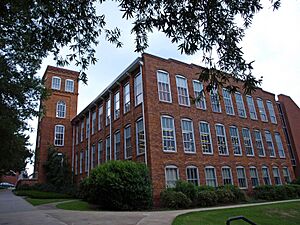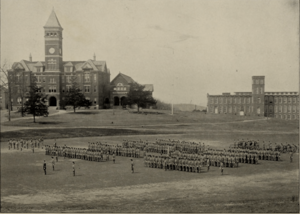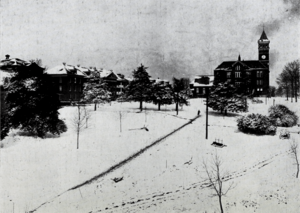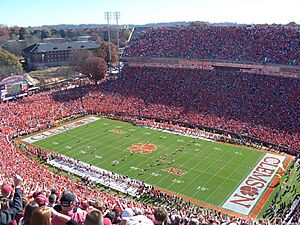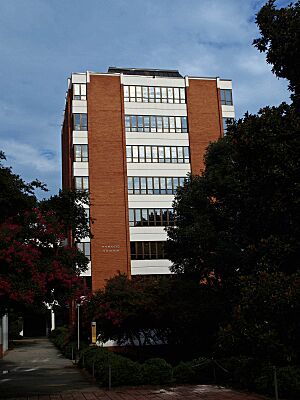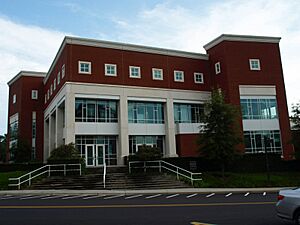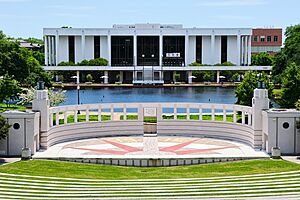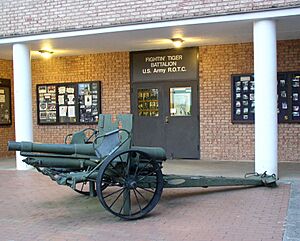Clemson University facts for kids
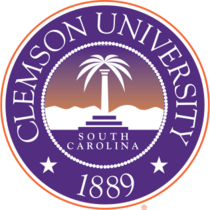 |
|
|
Former names
|
Clemson Agricultural College of South Carolina (1889–1964) |
|---|---|
| Type | Public land-grant research university |
| Established | 1889 |
| Accreditation | SACS |
|
Academic affiliations
|
|
| Endowment | $1.12 billion (2024) |
| President | James P. Clements |
| Provost | Robert H. Jones |
|
Academic staff
|
2,023 |
|
Administrative staff
|
4,616 |
| Students | 29,077 (Fall 2024) |
| Undergraduates | 23,401 (Fall 2024) |
| Postgraduates | 5,676 (Fall 2024) |
| Location |
Clemson postal address
,
,
United States
34°40′42″N 82°50′21″W / 34.67833°N 82.83917°W |
| Campus | Large suburb, 1,400 acres (570 ha) |
| Other campuses |
|
| Newspaper | The Tiger |
| Colors | Orange and regalia |
| Nickname | Tigers |
|
Sporting affiliations
|
NCAA Division I FBS – ACC |
| Mascot |
|
 |
|
Clemson University is a large public university located near Clemson, South Carolina, in the United States. It was started in 1889. Clemson is known for teaching about agriculture and mechanical arts, and it also does a lot of important research. It is one of the biggest universities in South Carolina by the number of students. In the fall of 2024, over 29,000 students attended Clemson.
The university's campus is about 1,400 acres (570 ha) big and is located in the foothills of the Blue Ridge Mountains. It is also next to Lake Hartwell.
Clemson University has nine main colleges or schools. These include colleges for Agriculture, Architecture, Arts and Humanities, Business, Education, Engineering, Science, Behavioral, Social and Health Sciences, and Veterinary Science. Clemson is recognized as a university with "Very high research activity."
Contents
History of Clemson University
How Clemson University Started
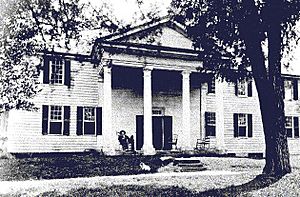
The founder of Clemson University was Thomas Green Clemson. He came to South Carolina in 1838 and married Anna Maria Calhoun, whose father was John C. Calhoun, a famous politician and former U.S. Vice President. When Thomas Green Clemson passed away in 1888, he left his family's land, called Fort Hill, and most of his money to start a college. He wanted this college to teach scientific agriculture and mechanical skills to people in South Carolina.
A future governor of South Carolina, Benjamin Tillman, helped make this happen. He worked hard to convince the state government to create the school as an agricultural college. The idea passed by just one vote! Thomas Green Clemson wanted the new school to be similar to what is now Mississippi State University.
Clemson Agricultural College Years
In November 1889, the governor of South Carolina signed the bill that officially created the Clemson Agricultural College of South Carolina. This meant that money from the government for agricultural education was moved to Clemson. Building the college began in 1890. Many of the first buildings were constructed by prisoners, some as young as 12 years old. Most of these prisoners were Black.
Henry Aubrey Strode was the first president of Clemson from 1890 to 1893. He hired teachers and planned what students would learn. The college officially opened in July 1893 with 446 students. For a long time, until 1955, Clemson was a military school only for white men.
In 1894, the main building, (Tillman Hall), was destroyed by a fire. It held the library, classrooms, and offices. But Tillman Hall was rebuilt that same year and is still standing today. The first students graduated from Clemson in 1896. They earned degrees in engineering and agriculture. Clemson's first football team also started in 1896.
In 1898, a textile department was created, making Clemson the first school in the Southern United States to train textile specialists. During World War I, fewer students attended Clemson. The university started a Reserve Officers' Training Corps (ROTC) program. Because of the war, Clemson also hired its first female teachers.
In 1925, another fire destroyed the inside of the agricultural building, including many research projects. The outside of the building survived, and Sikes Hall was built to hold the library. In 1928, Riggs Hall was built to honor former president Walter Riggs. During the The Great Depression, student numbers and money for the university went down. However, new dorms were built with government help to solve housing shortages.
During World War II, more than 6,500 Clemson students joined the military. Many became officers. Sadly, 376 Clemson students died in the war.
Becoming a Civilian and Integrated School
For many years, Clemson University only accepted white students. In the 1940s, several Black students tried to get into Clemson, but they were not allowed because of the segregation rules at the time. The university's leaders decided to keep Clemson segregated, telling Black applicants to go to South Carolina A&M instead.
In 1955, Clemson changed from being a military school to a "civilian" school. It also started admitting white women. However, it was still segregated by race. In 1957, Margaret Marie Snider became the first woman to earn a degree from Clemson.
In 1963, the university admitted its first African-American student, Harvey Gantt. He later became the mayor of Charlotte, North Carolina. Harvey Gantt and other Black students had tried to transfer to Clemson earlier but were rejected. Gantt and the NAACP (a civil rights organization) sued the university. In 1963, a court ordered Clemson to admit Gantt. Unlike some other schools, Clemson's leaders asked students to remain peaceful when Gantt enrolled, and the process went smoothly.
Also in 1963, Lucinda Brawley became the first Black woman admitted to Clemson.
Clemson University Today
In 1964, the college was officially renamed Clemson University. This change recognized that the school offered many more academic programs and did a lot more research than just agriculture and mechanical arts.
Campus Life
The main campus of Clemson University is located just outside the city of Clemson. It was originally the site of a plantation called Fort Hill, which belonged to U.S. Vice President John C. Calhoun. His daughter and son-in-law, Thomas Green Clemson, later owned it. When Thomas Green Clemson passed away, he left the land to the state to create the university.
Three of the original buildings from when the university was first built are still standing today: Hardin Hall (1890), Main Building (Tillman Hall) (1894), and Godfrey Hall (1898).
Academics and Learning
University Rankings
Clemson University is considered a very good school. US News Best National University Rankings places Clemson as tied for the 80th best national university in the U.S. overall and tied for the 39th top public school for 2025.
Applying to Clemson
It is quite competitive to get into Clemson. For the class that started in the fall of 2024, Clemson received over 61,000 applications and accepted about 38% of them. Of those accepted, about 20% chose to enroll. Most students who start at Clemson stay and graduate. About 94% of first-year students return for their second year, and about 85% graduate within six years.
Students who enrolled in the class of 2028 typically had strong test scores. The middle 50% of SAT scores ranged from 1250 to 1400, and ACT scores ranged from 28 to 32.
Colleges and Schools
Clemson University has nine academic colleges:
- College of Agriculture, Forestry and Life Sciences
- College of Architecture, Art and Construction
- College of Arts and Humanities
- College of Behavioral, Social and Health Sciences
- College of Education
- College of Engineering, Computing and Applied Sciences
- College of Science
- Wilbur O. and Ann Powers College of Business
- College of Veterinary Medicine
College of Agriculture, Forestry, and Life Sciences
This college helps Clemson University fulfill its original mission to provide education, research, and service to the public. Its research focuses on making agriculture, forests, and natural resources sustainable. It also works on food systems to ensure a safe food supply and studies biomedical sciences to improve health.
College of Architecture, Art and Construction
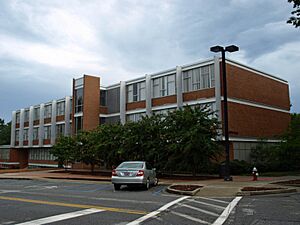
This college includes a School of Architecture, a Department of Art, and a department for Construction, Development, and Planning. The School of Architecture is highly ranked in the country. The Brooks Center is a place where students can perform arts.
College of Arts and Humanities
This college was created in 2023 and has six departments, including English, History, Languages, and Performing Arts. It also offers programs like Global Black Studies and World Cinema. The Brooks Center is also a performing arts venue for this college.
Wilbur O. and Ann Powers College of Business
This college is well-known and has received a large gift, leading to its new name. It is ranked among the top business schools. For example, it is ranked highly for its MBA programs, especially for Human Resources and Entrepreneurship.
College of Engineering, Computing and Applied Sciences
This college focuses on engineering and physical sciences like physics and chemistry. Since the first degrees were given in 1896, Clemson engineers and scientists have made important contributions to South Carolina and the world. This college was formed in 1995, bringing together engineering with chemistry, computer science, and other science departments.
Clemson University Honors College
The Honors College is for students who are highly motivated and very good at academics. It is very competitive to get in, with only about 250 new students accepted each year. These students usually have high test scores and were in the top of their high school class.
College of Education
The College of Education is one of Clemson's newer colleges. It has many undergraduate and graduate students. Its goal is to support a diverse group of students and teachers and give them many different experiences.
Graduate School
The Graduate School offers over 100 different graduate degree programs. These programs are available on the main campus and at other locations, like the Clemson University International Center for Automotive Research in Greenville and the Clemson Architecture Center in Charleston. Many of these programs are highly ranked.
Research at Clemson
Clemson University is a major research institution.
The Clemson University International Center for Automotive Research (CU-ICAR) was started in 2013 in Greenville. It's a large campus focused on automotive research and new ideas. The Automotive Engineering department there was ranked among the top in the world. Many big companies like BMW, Microsoft, and Michelin are partners with CU-ICAR.
The Charleston Innovation Campus in North Charleston was founded in 2004. It includes the Warren Lasch Conservation Center, which is working to preserve the H. L. Hunley, a Civil War submarine that was the first to sink a ship. This campus also has a large test facility for offshore wind turbines.
In 2016, Clemson started a big partnership with Siemens, which gave the university a lot of new software for engineering students.
Student Life and Activities
Intramural Sports
Clemson offers many intramural sports for students to play for fun, not just for competitive teams. These include:
- Basketball
- Billiards
- Bowling
- Cornhole
- Dodgeball
- Flag football
- Indoor soccer
- Kickball
- Racquetball
- Soccer
- Softball
- Spikeball
- Tennis
- Ultimate Frisbee
- Volleyball
- Wiffleball
Fraternities and Sororities
Clemson has a system of fraternities and sororities, which are social organizations for students. Unlike some other universities, there are no Greek houses directly on campus. However, there are special residence halls for these groups. Many students are involved in Greek life.
Military Programs
Clemson University has programs for the U.S. Army and U.S. Air Force Reserve Officers' Training Corps (ROTC). These programs help students train to become officers in the military after they graduate.
Student Media
Clemson University has five student-run media groups:
- The Tiger (newspaper)
- Tigervision (TV station)
- The Pendulum (international affairs magazine)
- The Chronicle (literary art magazine)
- WSBF-FM (radio station)
The Tiger newspaper started in 1907 and is the oldest student-run newspaper in South Carolina. Tigervision is the student TV station, and WSBF-FM is the student radio station, which plays a variety of music from independent artists.
Traditions
Tiger Paw Logo
The Tiger Paw became the official logo for Clemson University in 1970. You can see this paw print on all athletic teams' gear and on many documents. It's also painted on surfaces around campus and on roads leading to the university.
Homecoming and Tigerama
Every year, Clemson students celebrate Homecoming. This tradition started in 1914. During Homecoming week, student groups build special floats. These floats are shown and judged on the Saturday of the football game.
Since 1957, Clemson has also held "Tigerama" on the Friday night of Homecoming week. Tigerama is one of the biggest student-run pep rallies in the country, with about 40,000 people attending. It includes the crowning of Miss Homecoming, skits by student groups, and a fireworks show.
First Friday Parade
The First Friday Parade happens every year on the Friday before the first home football game. This parade includes fraternities, sororities, the Clemson marching band, the university president, and many other student organizations. A pep rally is held afterward in the university's amphitheater.
Alma Mater
The Clemson University alma mater (school song) was written in the 1910s. A student named A.C. Corcoran wrote the words in 1918. At first, it used the same tune as Cornell University's alma mater. In 1947, a contest was held to find a unique melody for Clemson's song. Robert E. Farmer, a student, won the contest. His melody was slightly changed in 1970 but was brought back to its original tune in 2009.
Fight Song
The university's fight song is a famous jazz standard called the "Tiger Rag".
Athletics
Clemson University's sports teams are called the Tigers. They compete in NCAA Division I sports. They are part of the Atlantic Coast Conference (ACC) for most sports.
Men's sports include baseball, basketball, football, golf, soccer, tennis, and track & field. Women's sports include basketball, cross country, golf, gymnastics, lacrosse, rowing, soccer, tennis, track & field, softball, and volleyball.
The main sports facilities on campus are Memorial Stadium (for football), Littlejohn Coliseum (for basketball), Doug Kingsmore Stadium (for baseball), Historic Riggs Field (for soccer), and Fike Recreation Center.
In 2020, the university initially decided to stop its Men's Track and Field and Cross Country teams. However, after students and state officials spoke up, the university changed its decision in April 2021. Clemson also announced that it would add women's lacrosse and gymnastics teams.
Notable People from Clemson
Notable Alumni
Many famous people have graduated from Clemson University.
Notable Faculty
Clemson University has had many notable professors, including:
- John Ballato, Professor of materials science and engineering.
- Donald D. Clayton, Professor of Physics & Astronomy.
- Jo Jorgensen, a political activist.
- Trudy Mackay, Professor of Genetics and Biochemistry.
- June Pilcher, Professor of Psychology.
See also
 In Spanish: Universidad Clemson para niños
In Spanish: Universidad Clemson para niños


